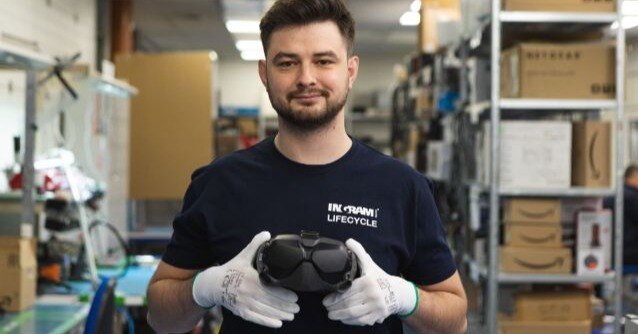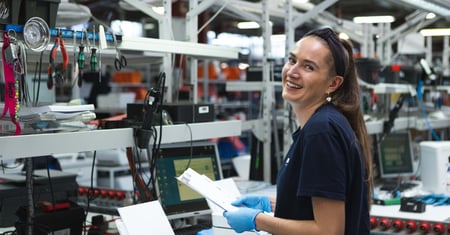The journey to finding a service provider that’s the best fit for your business’ returns management, product recovery, and recommerce can be long. Failing to make the right decision can be costly and unsustainable. Not knowing what the process involves, or should involve, can cause delays and prolong decision-making.
Ingram Micro Lifecycle works with a range of businesses across the globe to make their technology more sustainable. We support manufacturers, enterprises, retailers, insurers, and network operators in enabling a circular economy. Through our suite of solutions, we extend the lifecycle of high-end electronics including IT and mobility assets, gaming consoles, small domestic appliances, wearables, and mobile phones.
In this article, we demystify the process of engaging with a service provider. You’ll understand what’s involved right from the consultation through to project implementation.
1. Initial Consultation and Needs Assessment
After conducting your research to determine which service provider(s) have the market reputation that’s attractive to you, there are multiple ways in which you can contact them. Most commonly, it will be through their website.
Alternatively, you may email directly, or reach out to a member of their business development team, perhaps at an event or via LinkedIn. Once you’ve signalled your intention, there needs to be a two-way conversation that outlines your initial pain points, objectives, and business goals. This way your provider can understand what you need and how they can help you.
The response to your challenges and pain points can be addressed by means of a proposal, presentation or more formally via a Request for Information (RFI), Request for Proposal (RFP), or Request for Quotation (RFQ).
2. Tailoring Services to Specific Business Needs
Through close conversation, the service provider will learn more about what you’re trying to achieve, what perhaps isn’t working for you right now, and what your key success factors are. They will understand that each business is different and so is the product range and use. They will discuss with you the influencing factors of the project delivery, such as the range and scale, your user types, business models, and geographic coverage.
The objectives you’re looking to achieve will define what services are required. The levels to which services can be tailored to your needs can be simple or complex. It could be that the solution is simple repair and refurbishment, or perhaps you have a complex device that needs a bespoke solution with specialized tooling and areas (such as a clean room).
The main top-level aim is always to get the most from the product at the highest standard, in the quickest time.
Recovery methods range from basic manual disassembly to more complex semi- or fully-automated processes with non-intrusive repair and refurbishment methods. This is largely impacted by the commercials. In the case of repair, once products are processed, one stream will go back to the original owner, and another stream will be placed back into the market for deployment either back into a workplace or sold via a recommerce program.
Recommerce programs always require a mature, established network of trusted buyers to be able to supply these with high-quality second-life devices.
Supporting Modern Workplace as a Service
Hybrid and remote approaches to the workforce are becoming increasingly popular. Employees no longer need to be tied to the office in this modern approach. This can mean that enterprises have a fleet of devices that are deployed in the field.
Technology needs to be issued to new starters and also recovered from leavers. This can be from single locations, such as home offices, or central hubs.
Be sure that the provider you’re considering has the ability and processes to support this shift if it aligns with your objectives. Depot services and Device as a Service solutions enable these modern approaches to the workplace, managing IT assets remotely to relieve pressure from your internal IT teams. Solution capabilities should include holding stock, configuration of devices, shipping, in-life support, processing of leavers and end-of-life devices, and facilitating repairs, returns, swaps, and upgrades.
3. Understanding Service Level Agreements
Service Agreements are issued at the final stage of the consultation process. This follows the Request for Proposal and signing of the Non-Disclosure Agreement.
While you may not be fully aware of what solution you need, you know your problems inside out. You know what you want to achieve and what success looks like. The provider must build a relationship with you where you’re comfortable sharing your pain points and challenges so you can articulate a desired outcome.
Through two-way conversation, the provider should gain clarity and scope for the project ahead. It’s a consultative process, discussing ideas, sharing case studies of similar work, and designing a fresh solution that meets your needs of the project.
You must consider if the proposal fits your goals and objectives, meeting the expectations of your users and customers within an affordable budget.
After these consultative rounds and answering any questions that either side has, the Service Agreement is issued at the very end. This document details the parameters of the project and will be individual to your case and the chosen provider.
4. Implementation Strategy
Once the customer is satisfied with the proposal and contracts are signed, a project manager from your provider is assigned. They are the main point of contact for the customer and work to ensure that everything is delivered following the project plan that the customer has agreed to.
From there, your provider establishes recruitment and creation of new lines, if needed. Their IT teams will get any new systems set up and complete integrations before the project delivery begins.
5. Ongoing Support and Performance Monitoring
The service provider will establish a point of contact responsible for customer channels. Within their team, there will be a hierarchy that allows for a seamless escalation path should issues arise.
Each of these team members are central to the account and will act as a liaison between internal systems. This ensures one single source of information to give peace of mind that the program runs without issue. There will be regular check-ins to provide updates to the customer and take any action should the needs of the customer evolve.
Find your ideal service provider today
After you’ve researched potential providers that you’d consider working with, reach out to them with your RFI, RFP or RFQ. Through concise communication, the provider will work to understand your goals and will create a proposal. After some back and forth, the provider will shape the proposal to suit you. Once you’re happy, this is agreed and contracts are signed ahead of project implementation.
Ingram Micro Lifecycle, supported by Ingram Micro Inc., has a global presence and financial leverage that can enable the purchase of stock on behalf of customers. This lowers the financial risks for you with obtaining inventory and allows your funds to be used elsewhere within your operations.
Our breadth of services means we offer a true end-to-end solution with every part of the process housed within our facilities. This delivers improved processing speed and efficiency, while retaining complete control.
If you have any questions about this process then our team would be more than happy to assist you. Reach out to us today to discuss how our process works.
Recommended further reading:
- The importance of returns management, recovery, and recommerce
- Challenges of building recommerce networks
- Challenges when incorporating recovery & refurbishment
- 6 reasons to outsource rather than insource reverse logistics
- Returns management: how reverse logistics boosts customer satisfaction
- What is recommerce? Definition, benefits, and processes













